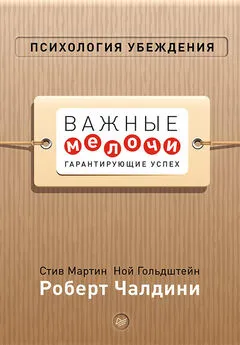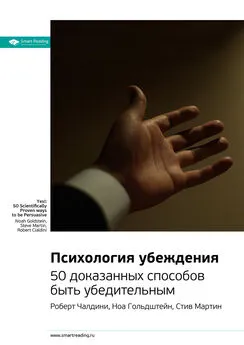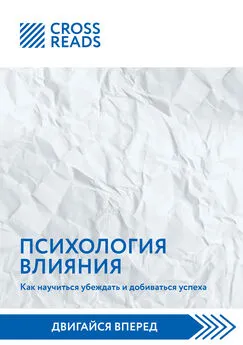Роберт Чалдини - Психология влияния
- Название:Психология влияния
- Автор:
- Жанр:
- Издательство:неизвестно
- Год:2001
- ISBN:нет данных
- Рейтинг:
- Избранное:Добавить в избранное
-
Отзывы:
-
Ваша оценка:
Роберт Чалдини - Психология влияния краткое содержание
«Психологию влияния» знают и рекомендуют в качестве одного из лучших учебных пособий по социальной психологии, конфликтологии, менеджменту все западные, а теперь уже и отечественные психологи. Книга Роберта Чалдини выдержала в США четыре издания, ее тираж превысил полтора миллиона экземпляров. Эта работа, подкупающая читателя легким стилем и эффектной подачей материала, является тем не менее серьезным трудом, в котором на самом современном научном уровне анализируются механизмы мотивации, усвоения информации и принятия решений.
Нет сомнения, что данная книга не только займет достойное место в библиотеке социального психолога, но и поможет в работе менеджерам, педагогам, политикам, всем, кто по роду деятельности должен убеждать, воздействовать, оказывать влияние.
Роберт Чалдини – профессор психологии Аризонского университета в Темпле, специалист в области экспериментальной и социальной психологии.
«Самая информативная и увлекательная работа из всех когда-либо написанных о влиянии людей друг на друга».
Дэвид Майерс, профессор психологии
«С полным основанием можно сказать, что в этой книге найдут для себя много интересного и поучительного все те, кому приходиться постоянно общаться по роду своей деятельности с широким кругом самых разных людей».
А. Л. Свенцицкий, доктор психологических наук, профессор СПбГУ
Психология влияния - читать онлайн бесплатно ознакомительный отрывок
Интервал:
Закладка:
Freedman J. L. (1984). Effect of television violence of aggressiveness. Psychological Bulletin, 96, 227-246.
Freedman J. L. & Fraser S. C. (1966). Compliance without pressure: The foot-in-the-door technique. Journal of Personality and Social Psychology, 4,195-203.
FrenzenJ. R. & Davis H. L. (1990). Purchasing behavior in embedded markets. Journal of Consumer Research, 17,1-12.
Fromkin H. L. & Brock Т. С. (1971). A commodity theory analysis of persuasion. Representative Research in Social Psychology, 2,47-57.
Fuller R. G. C. & Sheehy-Skeffington A. (1974). Effects of group laughter on responses to humorous materials: A replication and extension. Psychological Reports, 35,531-534.
Gaertner S. 1., Dovidio J. F., Rust M. C., Neir J. A., Banker В. S., Ward C. M., Mottola G. R., & Roulette M. (1999). Reducing intergroup bias: Elements of intergroup cooperation. Journal of Personality and Social Psychology, 76,388-402.
Ganzberg M. (1964, March 27). New York Times, p. 1.
Gamer R. L. (1999). What’s in a name: Persuasion perhaps? Unpublished manuscript, Sam Houston State University.
George W. H., Gournic S.J. & McAfee M. P. (1988). Perceptions of post drinking female sexuality. Journal of Applied Social Psychology, 18,1295-1317.
Gerard H. В. (1983). School segregation: The social science role. American Psychologist, 38, 869-877.
Gerard H.B. & Mathewson G. C.(1966). The effects of severity of initiation on liking fora group: A replication. Journal of Experimental Social Psychology, 2,278-287.
Gerard H. B. & Miller N. (1975). School desegregation. New York: Plenum.
Gergen K., Ellsworth P., Maslach C. & Seipel M. (1975). Obligation, donor resources, and reactions to aid in three cultures. Journal of Personality and Social Psychology, 31, 390-400.
Gigerenzer G., & Goldstein D. G. (1996).Reasoning the fast and frugal way: Models of bounded rationality. Psychological Review, 103, 650-669.
Gilbert D. T. & Osborne R. E. (1989). Thinking backward: Some curable and incurable consequences of cognitive business. Journal of Personality and Social Psychology, 57,940-949.
Glass 5. (1997, December). The Hollywood hustle. George, pp. 90-94.
Gleick E. (1997, February 10). Marine blood sports. Time, p. 30.
Goethals G. R. & Reckman R. F. (1973). The perception of consistency in attitudes. Journal of Experimental Social Psychology, 9, 491-501.
Gonzales M. H., Aronson E. & Costanzo M. (1988). Increasing the effectiveness of energy auditors: A field experiment. Journal of Applied Social Psychology, 18,1046-1066.
Gonzales M. H., Davis J. M., Loney G. L, Lukens C. K. & Junghans С. М. (1983). Interactional approach to interpersonal attraction. Journal of Personality and Social Psychology, 44, 1192-1197.
Goodenough U. W. (1991). Deception by pathogens. American Scientist, 79,344-355. Gordon R. E. & Gordon K. (1963). The blight on the ivy. Englewood Cliffs, NJ: Prentice-Hall.
Corn G.J. ( 1982). The effects of music in advertising on choice behavior: A classical conditioning approach. Journal of Marketing, 46,94-101.
Gould M. S. & Shaffer D. (1986). The impact of suicide in television movies. The New England Journal of Medicine, 315, 690-694.
Gouldner A. W. (1960). The norm of reciprocity: A preliminary statement. American Sociological Review, 25, 161-178.
Green F. (1965). The «foot-in-the-door» technique. American Salesman, 10,14-16.
Greenberg M. S. & Shapiro S. P. (1971). Indebtedness: An adverse effect of asking for and receiving help. Sociometry, 34, 290-301. Greenwald A. F., Camot C. G., Beach R. & Young B. (1987). Increasing voting behavior by asking people if they expect to vote. Journal of Applied Psychology, 72,315-318.
Gregory S. W., & Webster S. (1996). A nonverbal signal in voices of interview partners effectively predicts communication accommodation and social status perceptions. Journal of Personality and Social Psychology, 70,1231-1240.
Gruner S.J. (1996, November). Reward good consumers. Inc., p. 84.
CrushJ. E. (1980). Impact of candidate expenditures, regionality, and prior outcomes on the 1976 Democratic presidential primaries. Journal of Personality and Social Psychology, 38, 337-347.
Crush J. E., McKeough K. L. & Ahlering R. F. (1978). Extrapolating laboratory exposure experiments to actual political elections. Journal of Personality and Social Psychology, 36, 257-270.
Hammermesh D., & Biddle J. E. (1994). Beauty and the labor market. The American Economic Review, 84,1174-1194.
Harper C. R., Kidera C.J. & Cullen J. F. (1971). Study of simulated airplane pilot incapaci-tation: Phase II, subtle or partial loss of function. Aerospace Medicine, 42,946-948.
Heider F. (1946). Attitudes and cognitive organization. Journal of Psychology, 21,107-112.
Heilman M. E. (1976). Oppositional behavior as a function of influence attempt intensity and retaliation threat. Journal of Personality and Social Psychology, 33, 574-578.
Higgins E. Т., Lee J., Kwon J., & Trope J. (1995). When combining intrinsic motivation undermines interest. Journal of Personality and Social Psychology,68,749-767.
Higham P. A. & Garment D. W. (1992). The rise and fall politicians. Canadian Journal of Behavioral Science, 404-409.
Hill G. W. (1982). Group versus individual performance: Are N + 1 heads better than one? Psychological Bulletin, 91,517-539.
Hockey G. R.J. & Hamilton P. (1970). Arousal and information selection in short-term memory. Nature, 226, 866-867.
Holling C. K., Brotzman E., Dalrymple S., Graves N. & Pierce С. М. (1966). An experimental study of nurse-physician relationships. Journal of Nervous and Mental Disease, 143, 171-180.
Holldobler B. (1971). Communication between ants and their guests. Scientific American, 198, 68-76.
Homstein H. A., Fisch E. & Holmes M. (1968). Influence of a model’s feeling about his behavior and his relevance as a comparison other on observers’ helping behavior. Journal of Personality and Social Psychology, 10, 222-226.
Howard D.J. (1990), The influence of verbal responses to common greetings on compliance behavior: The foot-in-the-mouth effect. Journal of Applied Social Psychology, 20, 1185-1196.
Howard D.J., Gengler C. & Jain A. (1995). What’s in a name? A complimentary means of persuasion. Journal of Consumer Research, 22, 200-211.
Howard D.J., Gengler C. & Jain A. (1997). The name remembrance effect. Journal of Social Behavior and Personality, 12,801-810.
Hunt J. M., Domzal T.J. & Kernan J. B. ( 1981). Causal attribution and persuasion: The case of disconfirmed expectancies. In A. Mitchell (Ed.), Advances in Consumer Research (Vol. 9). Ann Arbor, MI: Association for Consumer Research.
James J. M., & Bolstein R. (1992). Effect of monetary incentives and follow-up mailings on the response rate and the response quality in mail surveys. Public Opinion Quarterly, 54, 442-453.
Johnson С. S. (1972). Fraternities in our colleges. New York: National Interfraternity Foundation.
Johnson D. W. & Johnson R. T. (1983). The socialization and achievement crisis: Are cooperative learning experiences the solution? In L. Bickman (Ed.), Applied social psychology annual (Vol. 4). Beverly Hills, CA: Sage.
Jones E. E. & Harris V. E. (1967). The attribution of attitudes. Journal of Experimental Social Psychology, 3,1-24.
Jones E. E. & Wortman C. (1973). Integration: An attributional approach. Morristown, NJ: General Learning Corp.
Joule R. V. (1987). Tobacco deprivation: The foot-in-the-door technique versus the low-ball technique. European Journal of Social Psychology, 17,361-365.
Kahn B. E., & Baron J. (1995). An exploratory study of choice rules favored for high-stakes decisions. Journal of Consumer Psychology, 17,361-365.
Kahneman D., Slavic P. & Tversky A. (Eds.). (1982). Judgment under uncertainty: Heuristics and biases. New York: Cambridge University Press.
Kamisar Y. (1980). Police interrogation and confession: Essays in law and policy. Ann Arbor: University of Michigan Press.
Katzev R. & Johnson T. (1984). Comparing the effects of monetary incentives and foot-in-the-door strategies in promoting residential electricity conservation. Journal of Applied Psychology, 14,12-27.
Katzev R. & Pardini A. (1985). The comparative effectiveness of token reinforcers and personal commitment in promoting recycling. Journal of Environmental Systems.
Keinan G, (1987). Decision making under stress: Scanning of alternatives under controllable and uncontrollable threats. Journal of Personality and Social Psychology, 52,639-644.
Kelman H. C. & Hamilton V. L. (1989). Crimes of obedience. New Haven, CT: Yale University Press.
Kenrick D. Т., Guitierres S. E. & Goldberg L. L. (1989). Influence of popular erotica on judgments of strangers and mates. Journal of Experimental Social Psychology, 25,159-167.
Kenrick D. T. & Keefe R. C. (1992). Age preferences in mates reflect sex differences in human reproductive strategies. Brain and Behavioral Sciences, 15, 75-133.
Kerr N. L. & MacCoun R.J. (1985). The effects of jury size and polling method on the process and product of jury deliberation. Journal of Personality and Social Psychology, 48, 349-363.
Ketelaar T. (1995, June). Emotions as mental representations of gains and losses: Translating prospect theory into positive and negative affect. Paper presented at the meeting of the American Psychological Society. New York, NY.
Kissinger H. (1982). Years of upheaval. Boston: Little, Brown.
Knishinsky A. (1982). The effects of scarcity of material and exclusivity of information on industrial buyer perceived risk in provoking a purchase decision. Doctoral dissertation, Arizona State University, Tempe.
Knouse S. В. (1983). The letter of recommendation: Specificity and favorability information. Personal Psychology, 36, 331-341.
Knox R. E. & InksterJ. A. (1968). Postdecisional dissonance at post time. Journal of Personality and Social Psychology, 8,319-323.
Kraut R. E. (1973). Effects of social labeling on giving to charity. Journal of Experimental Social Psychology, 9, 551-562.
Kruglanski A. E. & Freund T. (1983). The freezing and unfreezing of lay inferences: Effects on impressional primacy, ethnic stereotyping, and numerical anchoring. Journal of Experimental Social Psychology, 19,448-468.
Kulka R. A., KesslerJ. R. (1978). Is justice really blind? The effect of litigant physical attractiveness on judicial judgment. Journal of Applied Social Psychology, 4,336-381.
Kunz P. R. & Woolcott M. (1976). Season’s greetings: From my status to yours. Social Science Research, 5, 269-278.
Kurtzburg R. L., Safar H. & Cavior N. (1968). Surgical and social rehabilitation of adult offenders. Proceedings of the 76 th Annual Convention of the American Psychological Association, 3, 649-650.
Lack D. (1943). The life of the robin. London: Cambridge University Press.
Longer E.J. (1989). Minding matters. In L. Berkowitz (Ed.), Advances in experimental social psychology (Vol. 22). New York: Academic Press.Langer E., Blank A. & Cha-nowitz B. ( 1978). The mindlessness of ostensibly thoughtful action: The role of «place-bic» information in interpersonal interaction. Journal of Personality and Social Psychology, 36, 635-642.
Читать дальшеИнтервал:
Закладка:










